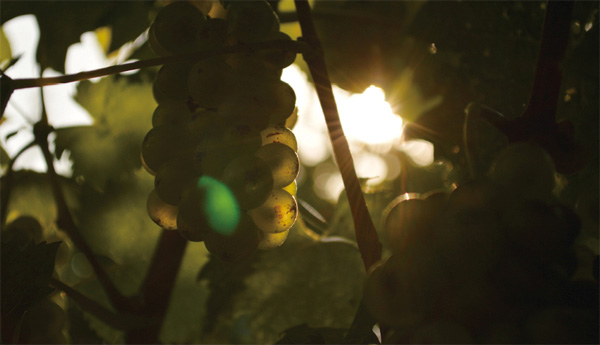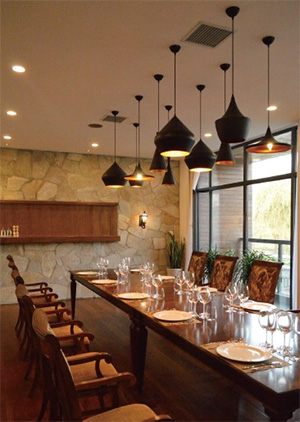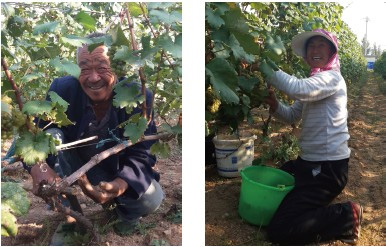Why did I Come to Love Pula Valley Winery Hub

September 26th, Yantai
The setting sun embraced the unripe grapevines, as well as bunches of Cabernet grapes that hanged regularly on the grapevines. Occasionally, some juice permeated out of the grapes and glittered with soft and golden sunlight. Some grape pickers squinted and raised their heads, appreciating the great harvest of this season.
There is a beautiful region named Pula Valley in Yantai, China. It is located in the same latitude as Bordeaux. With modern management and advanced planting techniques, Pula Valley will become one of the greatest wine region and terrior of China in the coming future.
In this ripe day, I stood in a vineyard of Pula Valley Winery Hub. In the distance were the chateau buildings under construction, which lied under some cranes and were surrounded by green grid guards. Due to painstaking efforts of the Pula Valley people, the construction drawings of world-class designers were gradually coming true.

Geographical Conditions
The Pula River, which flows westwards quietly and slowly, divides the winery hub into the north riverbank area and south riverbank area. Then, the river flows lengthwise through the Feng Mountain, forming the Feng Mountain area. This area abounds with herons. The birds usually flap the water surface during their flight, giving a sound of “Pula, Pula”. Local people say that the Pula River is named after that sound.
The three areas along the Pula River are all adjacent to mountains on their north and south sides. On the south of them is the Rosefinch Mountain, a municipal forest park, and on the north of them is the cloud-kissing Qing Mountain. The river is mingled with mountains, creating a charming scenery.
Located in Laishan District, Yantai City, Pula Valley Winery Hub is dominated by a warm temperate continental monsoon climate. Surrounded by the sea on three sides, the Winery Hub is characterized by moderate rainfall, humid air, and mild climate compared with the inland regions of its latitude. It has no severe cold in winter and no extreme heat in summer. Averagely, the annual frost-free period is up to 180 days, the annual sunshine duration is up to 2,698.4 hours, and annual relative humidity is 68%. Most of its land is loose sandy loam semi-sloping fields with good water seepage performance. Generally, the geographical conditions are very suitable for the long growth periodicity of grapes. Therefore, Pula Valley enjoys a good reputation of “China’s Bordeaux”.
The main landforms include low hills and hillocks. The Winery Hub covers an area of about 50 km2, and has the vineyards of 30,000 mu. According to the overall planning, a total of 100 wineries will be built. In Phase 1, 79 wineries have been completed. Currently, a total of 10 wineries are under construction. The Winery Hub integrates diversified functions including planting of grapevines, brewery of wine, propagation of the wine culture, SPA, tasting of wines and delicacies, art exhibition, and mountain sports. The Winery Hub is intended to become not only a winery hub but also a tourism resort that allows harmonious coexistence between humans and the nature, enables sustained development, reaches the international level, and integrates traditionality and modernity.

No Boundary between the New World and Old World
The wine fans not only like to shake the wine liquid in their glass cups, but also expect to pilgrimize in the cradleland of wines with dynamic force. In recent years, it has become a trend to visit and even invest in chateaus. With the favor for the wine industry, people gradually conceive an idea of building the own modern winery hub of China. Here, there is no line of demarcation between the new world and the old world.
As opposed to the European countries, China is a new comer of wine-manufacturing. However, this vast country boasts a golden grapevine belt, 30° to 50° of north latitude (the optimal latitude for growing of grapevines). Thanks to the great geographical advantages, China's wine industry is rapidly growing recently. Located in Yantai City, Shandong Province, Pula Valley Winery Hub will not only promote the globalization of China’s wine industry, but also provide an ideal destination for the wine fans to experience the wine culture.
Although not having a history as long-standing as that of the old world, the wine culture of China has won wide attention of the celebrities in the wine industry. Robert Tinlot, director of the International Vine and Wine Office (IWO), awarded the honorary title of “International Vine & Wine City” to Yantai City of China early in 1987. So far, Yantai is the only city that is awarded the honorary title in Asia. The annual wine yield of Yantai accounts for 30% of that in China while its production value of wine accounts for 50% of that in China.

Favorable Climatic, Geographical, and Human Conditions
The advantageous geographical location and growing environment have granted favorable conditions to Pula Valley Winery Hub. To support the development of the wine industry, China’s government has laid down the 12th- Five-Year Plan on the Wine Industry, thus offering a great opportunity to the Winery Hub. In addition, the entry threshold of the wine industry is raised in China, for example, 70% of raw materials of a winery are required to come from its own farm, so the wine brewed by a winery is essentially different from industrial alcohol. Due to the unified planning of growing base, R&D, wine culture, and manufacturing base, China is expected to further improve the quality of wines made in China.
In November 2010, Yantai Vine & Wine Bureau was formally set up, thus offering a further driving force to development of Yantai’s wine industry. As the only prefecture-level administrative organ of vine and wine in China, the bureau will surely provide powerful support for the “Go global” strategy of Yantai's wine industry. ”In China, the wine industry is a sunrise industry. As a major wine manufacturing base, Pula Valley Winery Hub will bring a new breakthrough in the wine industry of China. The local government not only grants financial allowance to each vineyard of at least 500 mu and interest subsidy to establishment of wineries, but also conducts publicity on a large scale.” Yi Fenghuang, director of Yantai Vine & Wine Bureau, said.
To plant the optimal varieties of grapevines suited to each farmland in the Winery Hub, the Winery Hub has engaged Jean-Pierre MERCIER (a world-class expert in grafting of grapevine seedlings) as technical consultant. Under the guidance of Jean-Pierre MERCIER, the Winery Hub will sample and test the soils of different land lots, select the optimal varieties of grapevines suited to each farmland, make technical evaluation of the grapevine seedlings planted in the farmlands regularly, and lay down a series of regulations and rules on management of vineyards and cultivation of seedlings. “Grafted seedlings will be planted in the vineyards, and such seedlings will be transported from France by air; although Pula Valley has the similar latitude to Bordeaux, but its climate is greatly different from the climate of Bordeaux, and cultivation of seedlings will face irresistible natural factors; but I’m sure that Pula Valley will offer us a unique flavor of grapes because of the naturally endowed geographical features.”Jean-Pierre MERCIER said.

The Winery Hub is committed to building different styles of wineries and brewing different flavors of wines.
Why couldn’t Pula Valley Winery Hub be called the fruit of favorable climatic, geographical and human conditions? It is endowed with favorable natural conditions, powerful support of governments, professional design team, and professional technical guidance. In the near future, you will surely see undulating vineyards and densely scattered wineries, taste top-grade wines, and experience the unique wine culture with both Western and Chinese styles.

Heritage
A bottle of wine not only gives a mellow taste, but also reflects local customs and painstaking efforts in artificial cultivation, fermentation, and brewing. The brewery history and brand of a winery will even leave a good reputation forever. In recent years, an increasing number of rich men and even enterprises have purchased foreign chateaus. Facing such trends, Lu Jiang (a wine expert of China) said: “Purchasing a chateau is a long-term investment rather than a once-for-all deal. After spending the first sum of money on the purchase, you will subsequently invest more.” As a matter of fact, this deal is different from purchase of real estate. After taking the possession of a chateau, you will not only acquire a high-quality lifestyle, but also inherit an asset. In the subsequent days, you’ll have to face various problems, for example, how to improve the soils, how to plant the grapevines, how to trim the grape leaves, how to pick the grapes, how to make wines, and so on.
After visiting various chateaus (for example, Bordeaux of France and Napa Valley of USA) in both the old world and new world, you perhaps can inspect Pula Valley Winery Hub, a winery hub pearl of China. Pula Valley Winery Hub is fitted with a wide diversity of facilities and is planned and managed in a unified manner. It provides each chateau with one-station technical guidance and services throughout the whole process, for example, planting of grapevines, picking of grapes, brewing of wines, sales agency, and entrusted management. The Winery Hub not only serves as an industrial incubator that promotes the propagation of the wine culture. As a powerful backup force for investors, the Winery Hub will assist the wine enthusiasts with their long-term brand strategy.
Meanwhile, the Winery Hub will develop brand images tailored to the preferences of investors and provide large-scale and industrialized support.
Statistics in the 12th Five-Year Plan on the Wine Industry show that China is the largest potential market of wine consumers in the world. In 2010, the global per-capita wine consumption was 7 liters. Specifically, the per-capita wine consumption of USA is 45 liters, the per-capita wine consumption of Argentina is 38 liters, while the per-capita wine consumption of China is less than 0.5 liters, only accounting for 6% of the global average level. Pula Valley Winery Hub is rapidly growing with the development of the wine industry and chateaus in China. It provides a perfect harmony between agriculture and manufacturing industry, between humans and the nature. An inheritable wealth appreciation system is coming into being during the propagation of the wine culture and in the luxuriantly green vineyards.